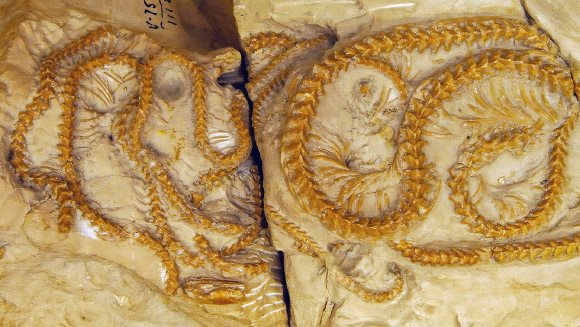Paleontologists have described a new species of snake from the Early Oligocene of Wyoming based on four nearly complete and articulated specimens found curled together in a burrow.
Hibernophis breithaupti lived 38 million years ago in what is now western Wyoming. Image credit: Jasmine Croghan.
Hibernophis breithaupti lived in North America 38 million years ago (Early Oligocene epoch).
It has unique anatomical features, in part because the specimens are articulated — meaning they were found all in one piece with the bones still arranged in the proper order — which is unusual for fossil snakes.
Hibernophis breithaupti is likely an early member of Booidea, a group that includes modern boas and pythons.
“Modern boas are widespread in the Americas, but their early evolution is not well understood,” said University of Alberta’s Professor Michael Caldwell and colleagues.
“These new and very complete fossils add important new information, in particular, on the evolution of small, burrowing boas known as rubber boas.”
“Traditionally, there has been much debate on the evolution of small burrowing boas.”
“Hibernophis breithaupti shows that northern and more central parts of North America might have been a key hub for their development.”
According to the team, Hibernophis breithaupti specimens have remained so remarkably well preserved for tens of millions of years because of their location.
“38 million years ago, when these particular Hibernophis breithaupti snakes were alive, the Southern Basin and Range Volcanic System was incredibly active and emitting huge quantities of volcanic ash,” said Professor Caldwell, senior author of the study.
“The ash settled and helped preserve the bodies of the creatures, which were found in a matrix of fine, sandy mudstone typical of the White River Formation.”
The paleontologists speculate that the animals fell victim to a small flood episode.
“They were preserved in a very unusual circumstance, geologically speaking,” Professor Caldwell said.
“Fossilization is a rough process. You need exactly the right conditions to preserve something.”
The discovery of four Hibernophis breithaupti individuals curled together also hints at the oldest potential evidence for a behavior familiar to us today — hibernation in groups.
“Modern garter snakes are famous for gathering by the thousands to hibernate together in dens and burrows,” Professor Caldwell said.
“They do this to conserve heat through the effect created by the ball of hibernating animals.”
“It’s fascinating to see possible evidence of such social behavior or hibernation dating back 34 million years.”
The study was published in the Zoological Journal of the Linnean Society.
_____
Jasmine A. Croghan et al. Morphology and systematics of a new fossil snake from the early Rupelian (Oligocene) White River Formation, Wyoming. Zoological Journal of the Linnean Society, published online June 19, 2024; doi: 10.1093/zoolinnean/zlae073








































































